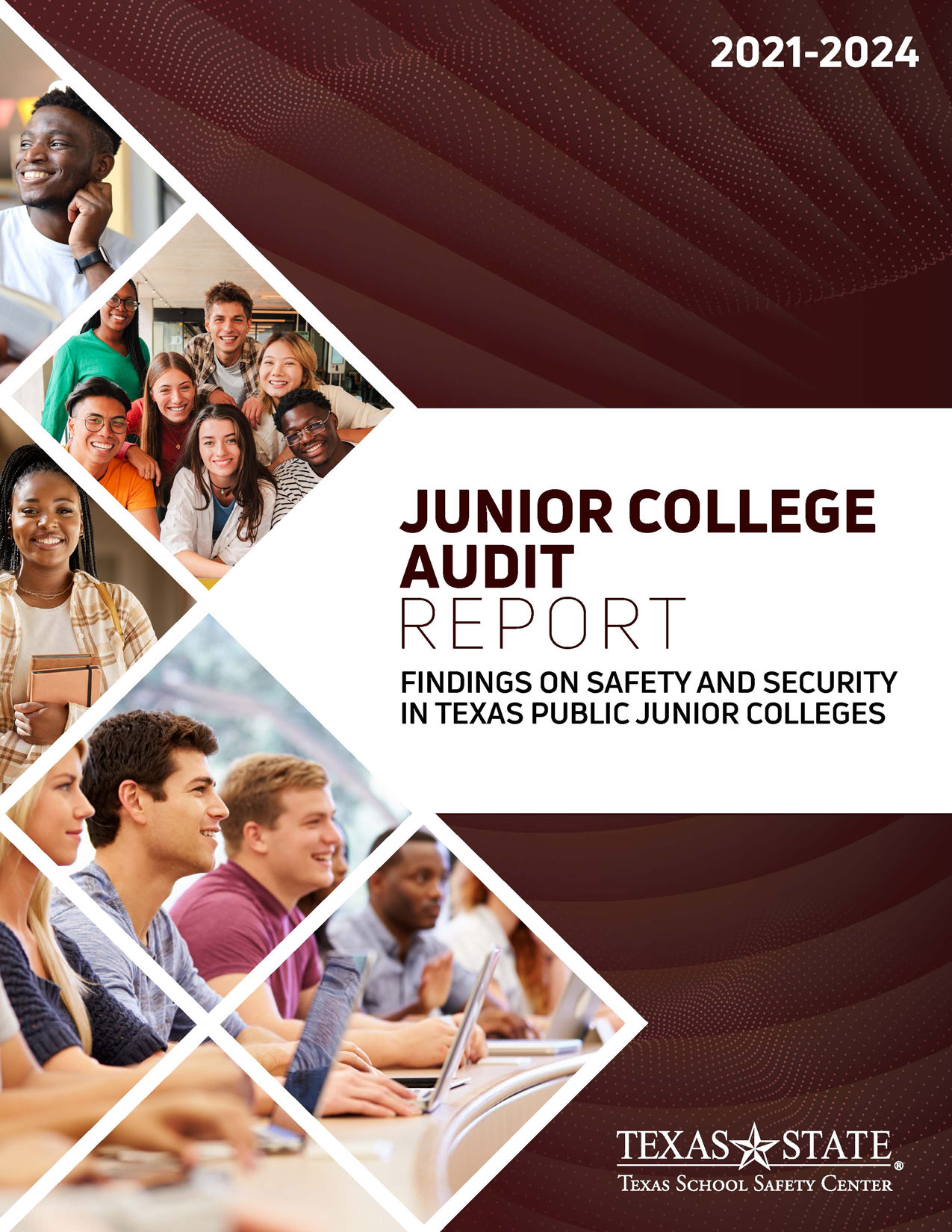TxSSC
2021-2024 Junior College Audit Report (JCAR)
Findings on School Safety and Security in Texas Public Junior College Districts

The purpose of the JCAR is to provide key results of the safety and security audits completed by Texas public junior community college districts (herein referred to as junior college districts). In accordance with procedures developed by the Texas School Safety Center (TxSSC) or an equivalent public or private entity, the Texas Education Code (TEC) requires junior college districts to complete safety and security audits of their facilities once every three years (§37.108 (4)(b)). Audits are conducted with the aim of identifying hazards, threats, and vulnerabilities that might pose a danger to life or property and/or may interfere with a safe, secure, and healthy environment that is conducive to higher education.
The TxSSC developed a model safety and security audit toolkit for junior college districts that provides guidelines showing proper audit procedures (§37.207 (1)). The audit toolkit for the 2021-2024 audit cycle included step-by-step instructions and recommendations for conducting audits, including a comprehensive audit checklist. The TxSSC captured key results of the safety and security audits completed by all Texas junior college districts. The data submitted by each junior college district were then aggregated into a statewide report for the public and the Texas State Legislature (§37.108 (4)(b)(c)); (§37.207 (3)).
“The purpose of the Junior College Audit Report (JCAR) is to provide key results of the safety and security audits completed by Texas public junior college districts.”
Methodology
The JCAR provides a summary of safety and security information for the reporting cycle September 1, 2021 through August 31, 2024. The report is comprised of self-reported data submitted by junior college districts in Texas. The TxSSC is authorized by the Texas Legislature to determine the method used to collect the audit results, as well as the type of data necessary for collection. Data was collected via the JCARtool, an online reporting application developed by the TxSSC.

The JCARtool was comprised of eight sections containing 43 single and multi-part questions. The eight sections of the JCARtool included: junior college district contact information, junior college district demographics, safety and security audit information, emergency management information, drilling, exercising, and training, behavioral threat assessment, additional safety and security information, and attestation. All data is self-reported by junior college districts.
The JCARtool was made available to districts to begin reporting audit results on April 15, 2024 and officially closed for reporting on September 15, 2024. In total, all 50 junior college districts (n=50) reported audit results via the JCARtool, for a response rate of 100 percent.
Major Findings
- The audit findings indicate 49 of the 50 junior college districts (98%) reported the results of their safety and security audit to the district’s board of trustees.
- The audit findings indicate 49 of the 50 junior college districts (98%) addressed all five phases in their Emergency Operations Plan.
- The audit findings indicate 49 of the 50 junior college districts (98%) ensured district employees have classroom access to a telephone, including a cellular phone, or another electronic device in their Emergency Operations Plan.
- The audit findings indicate 49 of the 50 junior college districts (98%) ensured their Emergency Operations Plan provides measures to train district employees in responding to an emergency.
- The audit findings indicate 34 of the 50 junior college districts (68%) reported their campuses or facilities had visitor policies/procedures that governed access.
- The audit findings indicate 24 of the 50 junior college districts (48%) had safety and security procedures in place for secondary school students attending programs on campus.
Recommendations
The findings from the 2021-2024 audit cycle identified nine key areas to serve as recommendations for improvement toward the safety and security of junior college districts in Texas. These recommendations serve to assist junior college districts to prevent/mitigate, prepare for, respond to, and recover from potential hazards, and will aid in the overarching goals of safety and emergency management—saving lives and protecting property.
- Recommendation 1: Junior college districts must continue to report the results of their safety and security audits to the district’s board of trustees.
- Recommendation 2: Junior college districts must continue to address all five phases in their Emergency Operations Plan.
- Recommendation 3: Junior college districts must continue to ensure their Emergency Operations Plan provides measures to train district employees in responding to an emergency.
- Recommendation 4: Junior college districts should have visitor policies/procedures that govern access.
- Recommendation 5: Junior college districts should review their procedures in place for secondary students.
- Recommendation 6: Junior college districts should drill for hazards.
- Recommendation 7: Junior college districts should conduct a comprehensive hazard analysis.
- Recommendation 8: Junior college districts should establish and maintain a team to conduct threat assessments.
Refer to the full Recommendations section on page 37 for details and resources pertaining to each recommendation.